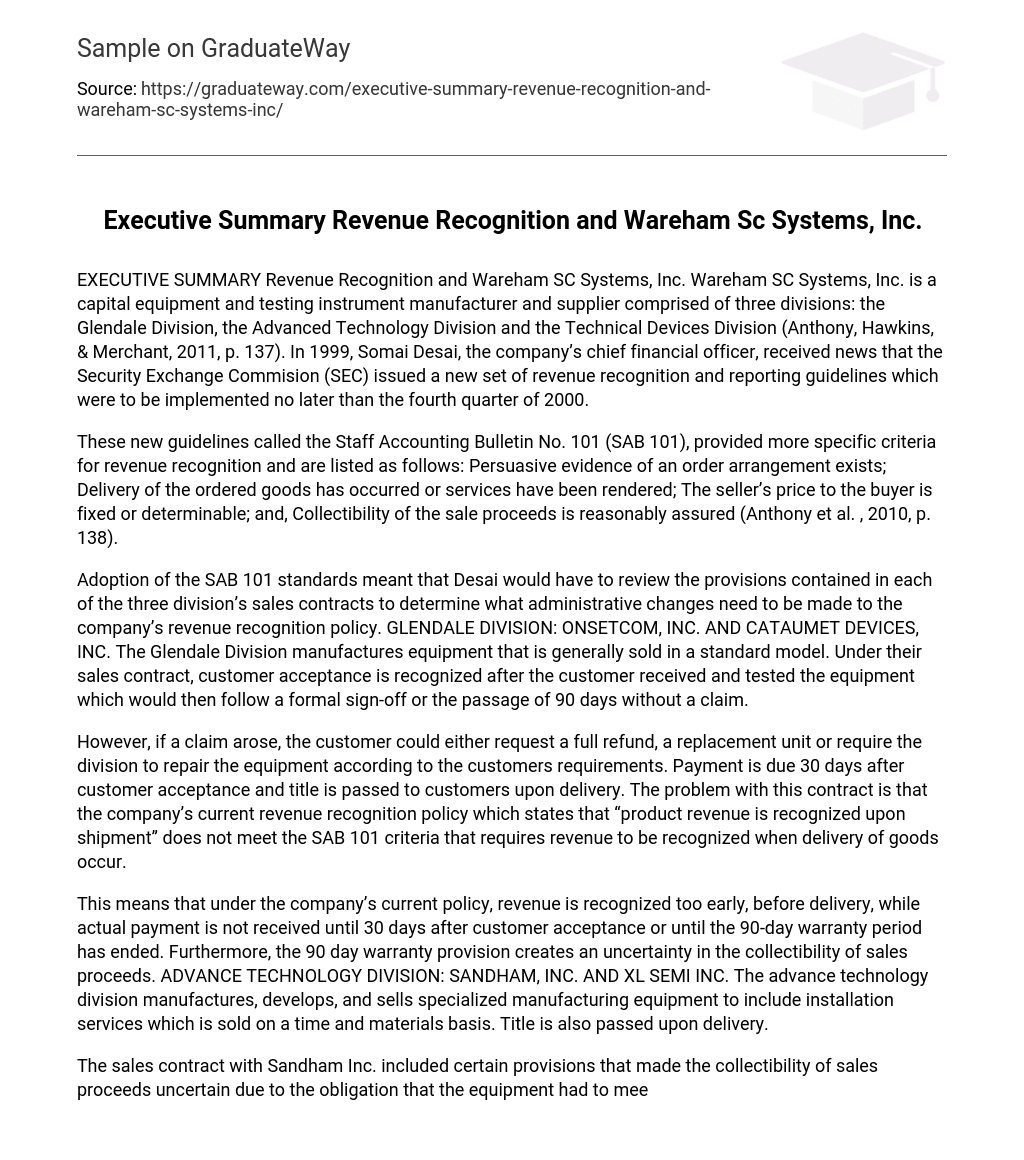EXECUTIVE SUMMARY Revenue Recognition and Wareham SC Systems, Inc. Wareham SC Systems, Inc. consists of three divisions: the Glendale Division, the Advanced Technology Division and the Technical Devices Division (Anthony, Hawkins, & Merchant, 2011, p. 137). In 1999, Somai Desai, the company’s CFO, was informed by the SEC about new revenue recognition and reporting guidelines that needed to be implemented by the fourth quarter of 2000.
These guidelines, known as Staff Accounting Bulletin No. 101 (SAB 101), offer more precise criteria for recognizing revenue. The criteria include: the presence of persuasive evidence of an order arrangement; delivery of the ordered goods or rendered services; a fixed or determinable price from the seller to the buyer; and reasonable assurance of collectibility of sale proceeds (Anthony et al., 2010, p. 138).
Desai would need to review the provisions in each division’s sales contracts to determine the necessary administrative changes for the company’s revenue recognition policy due to the adoption of the SAB 101 standards. The Glendale Division, including ONSETCOM, INC. and CATAUMET DEVICES, INC., manufactures equipment that is typically sold in a standard model. According to their sales contract, customer acceptance is acknowledged once the customer has received and tested the equipment. This acknowledgement is either confirmed through a formal sign-off or after 90 days without any claims.
The customer has the option to choose a full refund, replacement unit, or request the division to repair the equipment in case of a claim. Payment is due 30 days after customer acceptance, and title is transferred to customers upon delivery. However, the issue lies in the company’s current revenue recognition policy, which states that revenue is recognized upon shipment. This policy does not meet the SAB 101 criteria that require revenue to be recognized when goods are delivered.
This indicates that the company currently recognizes revenue before delivery, while actual payment is not received until 30 days after customer acceptance or until the 90-day warranty period ends. Additionally, the 90-day warranty provision creates uncertainty regarding the collection of sales proceeds. ADVANCE TECHNOLOGY DIVISION: SANDHAM, INC. AND XL SEMI INC. The advance technology division manufactures, develops, and sells specialized manufacturing equipment, including installation services, on a time and materials basis. Title is also transferred upon delivery.
The sales contract with Sandham Inc. contained provisions that made it uncertain whether the sales proceeds would be collected. This uncertainty arose from the requirement that the equipment had to be compatible with manufactured equipment from other companies, which Wareham was unable to replicate during testing at their facilities. Additionally, the contract included a customer acceptance provision, which stated that Sandham would receive a full refund if the product was not accepted within 120 days. These factors, along with the high development and manufacturing costs, increase the risk of significant revenue loss if the product is rejected.
For XL Semi, the cost of installation services can range from 1% to 3% of the total arrangement fee. However, this provision ignores the SAB 101 criteria, which states that the price should be fixed or determinable. Similar to the Glendale Division, both Sandham and XL Semi’s sales contracts have payment terms that result in recognizing revenue before actually receiving sales proceeds, which does not comply with SAB 101 guidelines.
TECHNICAL DEVICES DIVISION: NEW STRATEGY AND ASHABAN INDUSTRIES
The Technical Devices Division produces, develops, and markets various electrical, electronic, and mechanical testing devices. In the past, the division’s internal sales team handled sales to high-volume customers, while independent distributors handled sales to low-volume customers. However, in response to reduced demand and profitability, the division recently shifted the sale of high-volume mechanical testing devices to independent distributors. This change occurred just days before Desai announced her evaluation of the company’s sales transactions.
Distributors were instructed to expand their inventory from a short-term supply to a supply lasting two years. This action may indicate that the Technical Devices Division will potentially fall short of their profit targets for the quarter. Moreover, it raises concerns about the company’s financial statement, as it could be an attempt to inaccurately portray revenues. This behavior not only goes against the General Accepted Accounting Principles but also fails to fulfill the criteria which necessitate providing compelling evidence of an arrangement order.
In addition to the aforementioned challenges, there is further uncertainty regarding the ability to meet sales proceeds due to the unstable political situation in the former Soviet Republic. Moreover, the installation of the mechanical testing equipment sold to Ashaban by inexperienced local contractors, instead of the company’s engineers, will result in a higher number of rejected products by customers. Based on an examination of the selected sales transactions of each division, it is necessary to revise the company’s Revenue Recognition Policy in order to comply with SAB 101 regulations.
The current policy is flawed in recognizing revenues too early, which could result in overestimating revenues for the next period. Furthermore, the different provisions in each division’s sales contracts undermine the company’s ability to collect sales proceeds and raise the likelihood of substantial losses in sales revenues (Anthony, R. N., Hawkins, D. F., & Merchant, K. A., 2011).





